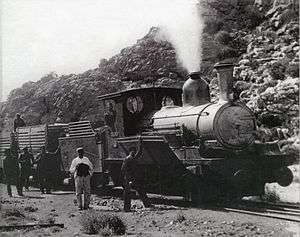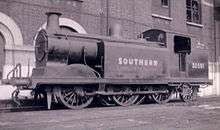0-6-2
Under the Whyte notation for the classification of steam locomotives, 0-6-2 represents the wheel arrangement of no leading wheels, six powered and coupled driving wheels on three axles and two trailing wheels on one axle. The type is sometimes known as a Webb or a Branchliner.
 Front of locomotive at left | |||||||||||||||
 Webb Coal Tank | |||||||||||||||
| |||||||||||||||
| |||||||||||||||
| |||||||||||||||
Overview
While some locomotives with this wheel arrangement had tenders, the majority were tank locomotives which carried their coal and water onboard.
Usage
Finland
.jpg)
Finland used two classes of 0-6-2T locomotive, the Vr2 and the Vr5.
The Vr2 class was numbered in the range from 950 to 965. Five of them are preserved in Finland, no. 950 at Joensuu, no. 951 at Tuuri, no. 953 at Haapamäki, no. 961 at Jyväskylä and no. 964 at the Veturimuseo at Toijala.
The Vr5 class was numbered in the range from 1400 to 1423. No. 1422 is preserved at Haapamäki.
South Africa
Tender locomotives
Between 1890 and 1898, four 0-6-2 tender locomotives were placed in service by the Cape Copper Company on its 2 ft 6 in (762 mm) gauge Namaqualand Railway between Port Nolloth and O'okiep in the Cape Colony. Acquired to meet the traffic needs of the upper mountainous section of the line, they became known as the Mountain type. The first three of these locomotives were later described as the Clara Class, while the fourth was included in this Class by some and included in the subsequent Scotia Class by others.[1]
Between 1900 and 1905, six more Mountain type 0-6-2 tender locomotives were placed in service by the Cape Copper Company. Later described as the Scotia Class, they were similar to the earlier Clara Class locomotives, but with longer boilers, longer fireboxes and larger firegrates.[1]
Tank locomotive
In 1892 and 1893, the Nederlandsche-Zuid-Afrikaansche Spoorweg-Maatschappij of the Zuid-Afrikaansche Republiek (Transvaal Republic) placed twenty 3 ft 6 in (1,067 mm) Cape gauge 0-6-2T locomotives in mainline service. Since the railway classified its locomotives according to their weight, these locomotives were known as the 40 Tonners.[2]
South West Africa
Three classes of 600 mm (1 ft 11 5⁄8 in) gauge 0-6-2 locomotives were supplied to German South West Africa between 1904 and 1908.
- In 1904, the Otavi Mining and Railway Company acquired fifteen tank locomotives from Arnold Jung Lokomotivfabrik in Germany. Two of them survived to be taken onto the South African Railways (SAR) roster in 1922. They were never classified and were referred to as the Jung locomotives.[3][4]
- Ten Class Ha tank locomotives were supplied by Henschel & Son in 1904. One survived the First World War into the SAR era.[3][5]
- Fifteen Class Hb tank locomotives were supplied by Henschel between 1905 and 1908. The last six locomotives were delivered as tank-and-tender engines, equipped with optional coal and water tenders. Six of them survived into the SAR era.[3]
United Kingdom
In the United Kingdom, the type was only ever used for tank engines and was first used by William Barton Wright of the Lancashire and Yorkshire Railway in 1880.[6]
The arrangement was soon afterwards used by F.W. Webb of the London and North Western Railway on his famous Coal Tanks of 1881-1897. Many locomotives of this type were also used to haul coal in the South Wales Valleys by the Great Western Railway and its predecessors.
Several railways around London later used the type for heavy suburban passenger trains, notably the following:
- The London Brighton and South Coast Railway (LB&SCR ) with the E3, E4, E5 and E6 classes designed by R. J. Billinton between 1894 and 1904.
- The Great Eastern Railway (GER) Class L77 of 1914, designed by Alfred John Hill.
- The Great Northern Railway (GNR) Class N1 designed by Ivatt, and Class N2, designed by Nigel Gresley between 1906 and 1921.
Gresley later improved upon the GER class with various versions of his London and North Eastern Railway (LNER) N7 class, built between 1925 and 1928.
United States of America
In the United States, 0-6-2 locomotives were largely 2-6-0 type locomotives which had been rebuilt with a larger firebox and therefore required greater weight distribution near their backs. The leading wheels were therefore relocated to the rear as trailing wheels. Nearly all of these locomotives were assigned to switch locomotive workings or used on branch lines.
Many 0-6-2 types were found in the state of Hawaii on sugar cane railroads across the state. Most notable were the 0-6-2T’s of the Mcbryde Sugar Company of Kauai, 3 of which survive and are currently the only original steam engines operating in Hawaii.
References
| Wikimedia Commons has media related to 0-6-2. |
- Bagshawe, Peter (2012). Locomotives of the Namaqualand Railway and Copper Mines (1st ed.). Stenvalls. pp. 8–11, 16–23. ISBN 978-91-7266-179-0.
- Holland, D.F. (1971). Steam Locomotives of the South African Railways. 1: 1859–1910 (1st ed.). Newton Abbott, Devon: David & Charles. pp. 113–114, 116, 121, 126. ISBN 978-0-7153-5382-0.
- Paxton, Leith; Bourne, David (1985). Locomotives of the South African Railways (1st ed.). Cape Town: Struik. pp. 115–116. ISBN 0869772112.
- Dulez, Jean A. (2012). Railways of Southern Africa 150 Years (Commemorating One Hundred and Fifty Years of Railways on the Sub-Continent – Complete Motive Power Classifications and Famous Trains – 1860–2011) (1st ed.). Garden View, Johannesburg, South Africa: Vidrail Productions. pp. 235, 379–382. ISBN 9 780620 512282.
- Henschel-Lieferliste (Henschel & Son works list), compiled by Dietmar Stresow
- Bertram Baxter, The British Locomotive Catalogue 1825-1923, Moorland Publishing, 1977, p.19.

